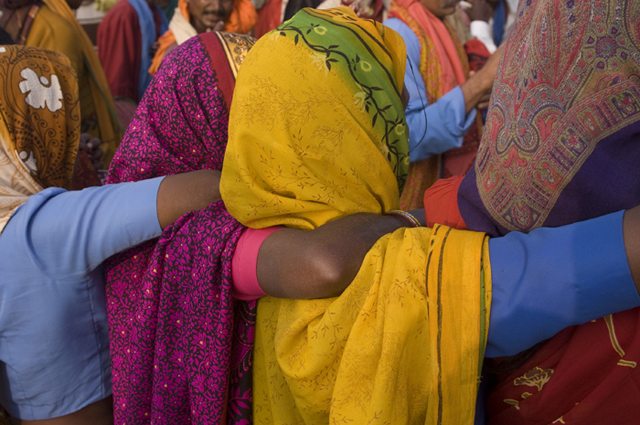
Stephen Huyler’s
‘Daughters of India: Art & Identity’
He first entered India not by plane or ship, but by bicycle-rickshaw, furiously pedaling away – with the rickshaw driver happily sitting in the passenger seat!
The year was 1971 and Stephen Huyler, a 19-year-old student from Ojai, California, had spent over two months traveling the overland route from Paris to India, shuttling in local trains and ramshackle buses across Asia, into Pakistan. At the border crossing, being on a shoestring budget and eternally curious, he decided to travel to Ferozepur and into India, by bicycle rickshaw.
“I was so amazed at the thought of somebody cycling me, who was just turning 20, who was a fit young American man, that I insisted on bicycling half the way myself. That’s how I entered India, bicycling a rickshaw, with the rickshaw-wallah sitting in the back, wondering what the hell I was doing!”
Fast forward 37 years and you find that empathy and deep curiosity are still strong features of Huyler’s relationship with India, and the love affair has blossomed over the years, with the noted art historian, author and photographer making the documentation of India’s crafts and people his life mission.
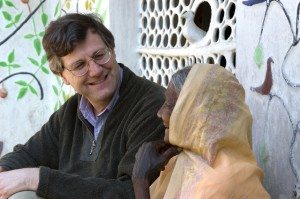
Huyler, who currently lives in Camden, Maine, has served as a curator and consultant for 25 museum exhibitions about India, including those at the Smithsonian in Washington and the AmericanMuseum of Natural History in New York.
Yet he remains the chronicler of the real stories of real people, of struggles lived, joys celebrated, of art and identity entwined in millions of households across India. His stories, through in-depth field research and images, shine a light on quiet, anonymous lives.
For four decades, he has traversed the Indian-subcontinent, visiting every district in every state, except the Northeast. During 60 visits from America, he has visited hundreds of villages, small towns and cities and used every mode of transport from air to boat to phut-phut. His deep affection and respect for India and its culture seems almost engrained, inborn.
How did he get so interconnected with a country oceans and continents away?
His grandparents and parents were educators in Korea and a grand-aunt had set up the largest women’s university in Seoul, so reaching out to the larger world seems to be in his DNA. He says, “My family is very, very interested in people of other cultures – they are imbued with a fascination for other cultures.”
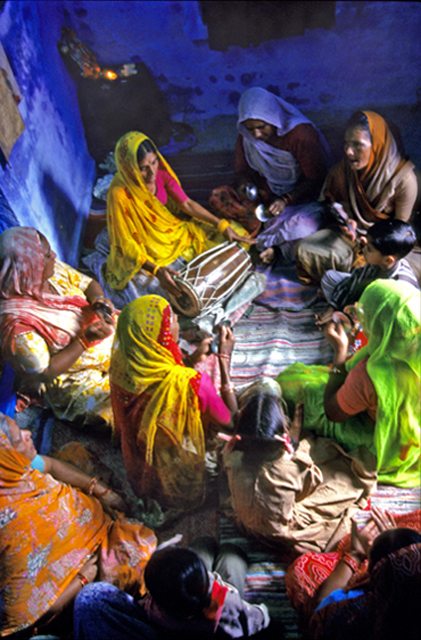
He was fortunate to have a bit of India right in his backyard: Huyler grew up in Ojai, California, a stone’s throw from the house where the Indian philosopher Jiddu Krishnamurthi lived and he was exposed to him and his ideas at an early age. Through Krishnamurthi he also met two dynamic Indian women, freedom fighter Kamladevi Chattopadhyaya and dance icon Rukmini Devi Arundale, who introduced him to India.
Another big influence in his teens was the friendship of the noted American artist Beatrice Wood who loved India with a passion. She had been influenced by Hindu philosophy and after her visit to India she always wore sarees and ethnic jewelry. Recalls Huyler: “She took me under her wing and was a major mentor in my life – she introduced me to India.”
For Huyler, the challenge was not only understanding Indian craftsmanship and folk art from an art historical perspective but really trying to understand it from the basis of the people, what it meant to them, and how it was used. In his work, art and people are always interconnected, giving a human element to something which can be very esoteric.
“Art history – its styles, forms and techniques – often looks at art as divorced from people but I was interested in what it had to do with rituals and with functions in the home or the temple,” he says. “I realized that it would be a lifelong work and I would not even be able to think about publishing anything for years and it would be too massive an undertaking. I did field research for many years before I even attempted to write an article. I just kept going back.”
So does he find arts and crafts central to Indian life? “I would say creativity is central to humanity and to India and art and crafts are a form of creativity, no more so than music or dance but it’s a visual expression of creativity and it’s one that I can photograph,” he says. “I don’t think art and crafts define the people of India – I think they are very creative in many, many spheres – amongst them being creative in computer programming – but art is visually evocative and helps in telling a story.”
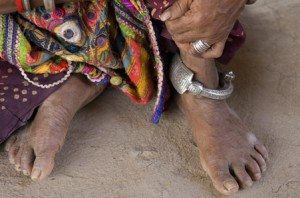
One in every six women in the world lives in India, and ‘Daughters of India’ tells the story of Indian womanhood through tales of 20 women from diverse parts of the nation, with over 250 lush photographs, using their art to link their stories. Huyler feels reportage about Indian women is often misinformed, and he hopes to set the record straight by showing their strengths, their creativity, and their ability to rise above difficulties. He is donating the profits from the book to seven organizations that empower women.
As he points out, ‘Daughters of India’ is really not a book about art – it’s a book about the women but he uses art as a way of linking their stories together: “The trademark of India always is its ability to adapt to change and in the 21st century that adaptability to change is phenomenal. The book is not anchored in tradition per se but in the way women use their own creativity to make change in their lives, to meet their challenges and improve their lives. It is visually sumptuous because India is visually sumptuous.”
While Huyler sought out some of these women, the majority of them came to him by serendipity. He says, “I don’t seek out stories – the stories come to me. Almost every story just happened. India is a very hospitable country and people invite me for a cup of tea or sometimes for a meal in their homes; I meet them and they tell me their stories.”
While each woman’s story is powerful in the unique way she has met life’s challenges, Huyler was most moved by the story of Sonabai, a villager from Chhatisgarh, who was not allowed by her difficult husband to leave her home for 15 years. She taught herself to work with clay, and her whimsical figures brightened up her lonely existence. Today her sculptures have taken her abroad, to museums and acclaim.
Says Huyler: “Sonabai drew from within the depths of herself in the face of phenomenal adversity through creativity, and truly changed her environment and made delightful a life that would otherwise have been dark and foreboding.” In fact, Huyler’s next book is titled ‘Sonabai: Another Way of Seeing’ and will be accompanied by an exhibition in San Diego.
Ask Huyler for one special memory of the women he has encountered, and he says: “There are so many – my mind flashes with hundreds of them. I cannot isolate one – it’s echoed time and time again – a thousand times where I look into someone’s eyes that I’d expect to be dejected because of the circumstances of life and I find a level of pride and humor and presence that meets me eye to eye and says, ‘I am who I am and I am OK’, that doesn’t look for pity.”
He adds, “And that I see again and again and I am in constant awe of that. It’s that sense of deep pride, purposeful pride in identity of place, identity of who people are, where they are and where they are going in life. It’s very beautiful, it’s very moving and that’s what keeps bringing me back to India.”
© Lavina Melwani
Photographs © Stephen Huyler
Daughters of India
Each of the women profiled in ‘Daughters of India’ has faced small and big challenges and prevailed. They include Puspha, a sweeper at Mumbai’s Chatrapati Shivaji International Airport who has been the sole support of her family; Lalita, a village woman in Begampura in Rajasthan, who along with the women of her extended family paints the walls and floor of their home with sacred designs; Kusha, a tailor in Badami in the Bijapur district of Karnataka is a widow with a physically challenged son; and Samabai in Ludiya, Kucchh district in Gujarat, who has made a new life for her family through intricate traditional embroidery. In each of the stories, Huyler takes you into the complexities of simple lives and captures the routines through beautiful photographs.
He also balances out the portrait of Indian womanhood through profiles of Achamma Joseph, an IT entrepreneur in Kochi, Kerala and Bangalore, Karnataka, who has made it big in a man’s world, launching successful software companies; then there’s Minhazz Majumdar, a progressive Muslim woman from New Delhi who advocates on behalf of the artists and craftspeople through her non-profit group.
Shyamali Khastgir, an artist-activist at Santiniketan in West Bengal, has been an outspoken protestor, be it the building of dams on the Narmada or nuclear testing in Pokharan. Now she uses art to make her protests, painting on cotton evocative words and images against war, injustice and environmental destruction.
Another impressive figure is Chandaben Shroff who has spent a lifetime training and nurturing village women in Kachchh to streamline their work for the contemporary fashion market through the organization she founded, Shrujan. From first training 30 women, the center now assists 3000 women artisans, and has a design bank of over 1100 embroidered textile panels, which is taken from village to village as a learning tool to help women market their embroideries and make a good living.
(C) Stephen Huyler

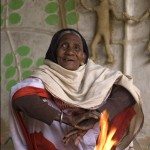


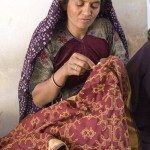
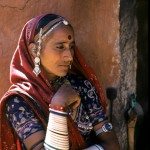
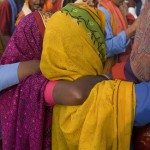
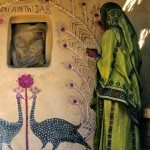
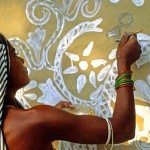
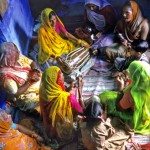
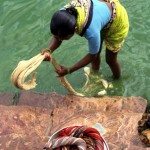
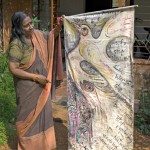
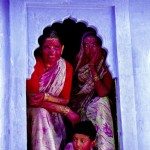
2 Comments
Prem, I greatly admire Stephen Huyler’s work – and would love to follow up on his new books. That was quite a compliment you received, and one certainly to treasure!
I have also reviewed Stephen Huyler’s book Daughters of India. I met him years ago when he was working on an India project…Indian Worship rituals in the US for the Smithsonian. I collected a few photographs and I do believe one of them is still there in the exhibit!
Met Stephen again a couple of years ago at the Fowler Museum when he autographed his book Daughters of India for me. I will cherish it for ever,
This is what he wrote
For Prem
who has written one of my finest reviews of this book and is a remarkable Daughter of India herself. Gratefully, Stephen Huyler